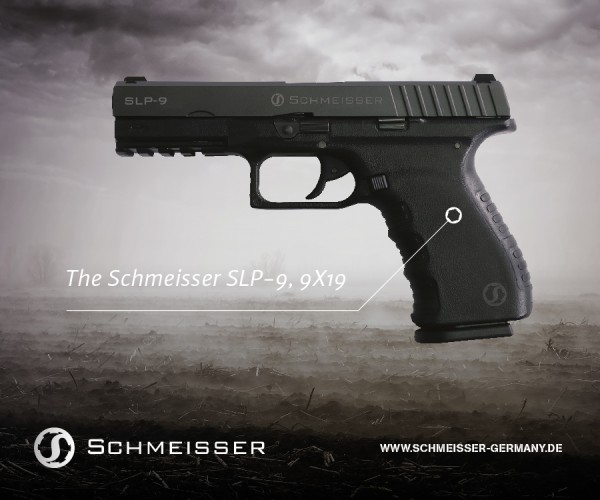
Late last week we learned that O’Dell Engineering Ltd. will be importing a new pistol for commercial distribution here in Canada: The Schmeisser SLP-9.
Schmeisser, as a brand, already has a small but well-deserved reputation for building very high quality AR-15s using quality components like Lothar Walther barrels and bolts made from a unique steel developed by Thyssen Krupp. Their new SLP-9 pistol takes that same idea of improving upon an existing design to create something not altogether ground-breaking, but rather, improved by a measure of slight degrees.
So, with that said, we’ll get this out of the way: In some ways this is, yes, another Glock clone insofar as it is a blocky striker-fired pistol with a polymer frame. But that’s pretty much where the similarities stop. The grip angle looks less aggressive than the Luger-esque silhouette of a Glock, the trigger doesn’t appear to have a safety mechanism stuck in the middle of it, and the take-down mechanism looks more like that of an M&P than it does the silly little serrated bar of a Glock’s. The magazine release appears to be ambidextrous from the factory, the railed dust cover has standard 1913-spec slots, and the sights are not plastic dovetail protectors, such as Glocks ship with.
But if you read all those design differences and thought “meh, those are just ergonomic differences, it’s still a Glock inside I bet,” you’d be wrong. The big deviation of the Schmeisser SLP-9 is internal. See, in most striker-fired pistols, the striker assembly is retained somewhere between halfway and totally compressed. In a Glock, the striker is kept about halfway compressed, and pulling the trigger moves the striker further to the rear, before the trigger breaks and the striker spring pushes the striker forward; firing the round. In the newer style of “single-action” style striker-fired pistols such an H&K’s new striker fired pistols or Walther’s PPQ, the striker is retained further rearward by the sear, requiring less effort and travel of the trigger, as squeezing the trigger doesn’t move the striker as far rearward before it is released.
You’ll note we put quotations around the term “single-action” back there. While manufacturers may throw the term around to make potential buyers think their new polymer pistol will have a 1911-like trigger, the reality is that with a single exception (until now), striker-fired guns have been varying degrees of single-action. The amount of movement imparted on the striker assembly by the trigger has been the determining factor in how “single-action” they are. A Glock for example, is maybe a 1.5x action, in that half of the cocking action is accomplished by the trigger. A PPQ or new VP9 is closer to a true single-action in that the trigger is responsible for less of the cocking action.
The Schmeisser SLP-9 is one of only two true double-action/single-action striker-fired pistols (the hideous Walther P99 being the other). The trigger is capable of bringing the striker from a fired position, to fully cocked, before the sear releases the striker and fires the round. Once the slide cycles with the trigger depressed, the striker is retained in a rearward position, and once the trigger has been allowed to return to its short reset position it can be pulled again to fire the remaining rounds with a much shorter trigger travel. If a round should fail to go off, the shooter can allow the trigger to travel out to the limit of its travel, where it will again engage the striker from a fired position and drag it all the way back to fully cocked before firing again, like a conventional hammer-fired DA/SA pistol.
Obviously this is a pretty big departure for striker-fired pistols. It means there’s no more need for strange safety mechanisms on the trigger since the first pull is a safe DA-style long press, and it means shooters can now get that much-beloved second-strike capability. Combine that, with the ergonomic improvements we outlined earlier and Schmeisser’s reputation for German-built quality firearms, and this could be a real winner. Expect a price tag of $749. Check back for a full review as soon as we can get our hands on one!